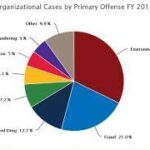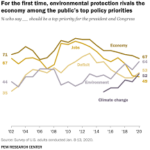Introduction

Environmental crime poses a significant threat to the well-being of ecosystems, human health, and sustainable development. In the United States, despite regulatory frameworks aimed at safeguarding the environment, instances of environmental crime persist, encompassing a range of illicit activities from pollution to wildlife trafficking. This paper provides a comprehensive examination of environmental crime in the USA, highlighting key issues, challenges, and potential solutions.
Type of environmental crime
Environmental crimes encompass a wide range of illegal activities that harm the environment. Some common types of environmental crimes in the USA include:

- Illegal dumping and disposal of hazardous waste.
- Pollution of air, water, and soil through industrial activities.
- Illegal wildlife trafficking and poaching.
- Illegal logging and deforestation.
- Illegal fishing and overfishing.
- Destruction of protected habitats and ecosystems.
- Violations of environmental regulations by corporations and industries.
- Illegal trade and disposal of electronic waste (e-waste).
- Illegal mining activities causing environmental degradation.
- Unauthorized construction in environmentally sensitive areas.
Causes of Environmental Crime:
Several factors contribute to the perpetration of environmental crimes in the USA:

- Profit Motive: Many environmental crimes are driven by the pursuit of profit. Illegal activities such as wildlife trafficking, illegal logging, and dumping of hazardous waste are often lucrative businesses for criminal enterprises.
- Weak Enforcement: Inadequate enforcement of environmental laws and regulations creates opportunities for individuals and businesses to engage in illegal activities with impunity.
- Lack of Awareness: Some individuals may commit environmental crimes due to a lack of awareness about the consequences of their actions on the environment.
- Regulatory Gaps: Loopholes and gaps in environmental regulations may enable perpetrators to exploit weaknesses in the legal framework for their benefit.
- Corruption: Corruption within regulatory agencies can facilitate environmental crimes by allowing offenders to evade detection and punishment.
- Demand for Illegal Goods: The demand for products derived from illegal environmental activities, such as exotic wildlife, timber, or seafood, fuels criminal enterprises engaged in these practices.
Impacts of Environmental Crime:
The consequences of environmental crime are profound and wide-ranging:

Ecological Damage
Illegal activities such as deforestation, pollution, and habitat destruction have detrimental effects on ecosystems, leading to loss of biodiversity and disruption of ecological processes.
Public Health Risks:
Pollution from illegal waste disposal and industrial activities can contaminate air, water, and soil, posing health risks to communities living in affected areas.
Economic Losses:
Environmental crimes impose significant economic costs, including cleanup expenses, lost revenue from tourism and fisheries, and diminished property values.
Social Injustice:
Environmental crimes often disproportionately affect marginalized communities, exacerbating social inequalities and environmental injustice.
Threats to National Security

: Some forms of environmental crime, such as illegal trafficking of hazardous materials or exploitation of natural resources in conflict zones, can pose threats to national security and stability.
Regulatory Framework:
The USA has a comprehensive regulatory framework governing environmental protection and natural resource management. Key laws and agencies involved in combating environmental crime include:
The Clean Air Act (CAA) and Clean Water Act (CWA):
These federal laws regulate air and water quality standards, emissions, and pollution control measures.
The Resource Conservation and Recovery Act (RCRA): This law addresses the management and disposal of hazardous waste, including regulations on storage, transportation, and treatment.
The Endangered Species Act (ESA): The ESA protects endangered and threatened species and their habitats, prohibiting activities that harm or disrupt their survival.
The Environmental Protection Agency (EPA): The EPA is the primary federal agency responsible for enforcing environmental laws, conducting research, and implementing pollution control programs.
The Department of Justice (DOJ): The DOJ prosecutes environmental crimes under various federal statutes, working in collaboration with other agencies to investigate and deter illegal activities.
Enforcement Efforts:

Efforts to combat environmental crime in the USA involve a multi-faceted approach, including:
Law Enforcement: Federal, state, and local law enforcement agencies collaborate to investigate and prosecute environmental crimes, targeting offenders engaged in illegal activities such as pollution, wildlife trafficking, and illegal dumping.
Regulatory Compliance: Regulatory agencies conduct inspections and audits to ensure compliance with environmental laws and regulations, imposing penalties on violators and requiring corrective actions to mitigate environmental damage.
Public Awareness and Education:
Outreach programs and public awareness campaigns aim to educate individuals and businesses about environmental regulations, the consequences of environmental crime, and the importance of environmental stewardship.
International Cooperation:
The USA participates in international initiatives and treaties aimed at addressing transnational environmental crimes, such as illegal wildlife trafficking and illegal fishing, through collaboration with other countries and international organizations.
Technological Solutions: Advances in technology, such as remote sensing, geographic information systems (GIS), and environmental monitoring tools, enhance detection and surveillance capabilities, aiding enforcement efforts against environmental crime.
Future Prospects:
Despite ongoing challenges, efforts to combat environmental crime in the USA are evolving to address emerging threats and strengthen enforcement mechanisms. Key areas for future action include:
Strengthening Regulatory Frameworks:
Enhancing and updating environmental laws and regulations to address emerging issues and close regulatory gaps is essential for effective environmental protection.
Enhancing Enforcement Capacity:
Investing in training, resources, and technology for law enforcement agencies can improve their ability to detect, investigate, and prosecute environmental crimes.
Promoting Corporate Accountability:
Holding corporations and industries accountable for environmental violations through enforcement actions, fines, and penalties can deter illegal activities and promote responsible business practices.
Fostering International Cooperation:
Strengthening international cooperation and collaboration is crucial for addressing transnational environmental crimes and tackling global environmental challenges.
Empowering Communities:
Engaging local communities and stakeholders in environmental protection efforts, including monitoring and reporting illegal activities, can enhance enforcement effectiveness and promote environmental stewardship at the grassroots level.
Conclusion:
Environmental crime poses significant threats to the environment, public health, and socio-economic well-being in the USA. Addressing these challenges requires a comprehensive approach involving robust regulatory frameworks, effective enforcement mechanisms, public awareness, and international cooperation. By addressing the root causes of environmental crime and promoting sustainable practices, the USA can safeguard its natural resources and contribute to global efforts to protect the environment for future generations.



